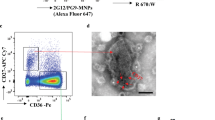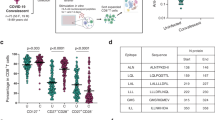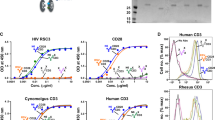Abstract
Cell-free human T-lymphotropic virus type 1 (HTLV-1) virions are poorly infectious in vitro for their primary target cells, CD4+ T cells. Here, we show that HTLV-1 can efficiently infect myeloid and plasmacytoid dendritic cells (DCs). Moreover, DCs exposed to HTLV-1, both before and after being productively infected, can rapidly, efficiently and reproducibly transfer virus to autologous primary CD4+ T cells. This DC-mediated transfer of HTLV-1 involves heparan sulfate proteoglycans and neuropilin-1 and results in long-term productive infection and interleukin-2–independent transformation of the CD4+ T cells. These studies, along with observations of HTLV-1–infected DCs in the peripheral blood of infected individuals, indicate that DCs have a central role in HTLV-1 transmission, dissemination and persistence in vivo. In addition to altering the current paradigm concerning how HTLV-1 transmission occurs, these studies suggest that impairment of DC function after HTLV-1 infection plays a part in pathogenesis.
This is a preview of subscription content, access via your institution
Access options
Subscribe to this journal
Receive 12 print issues and online access
$209.00 per year
only $17.42 per issue
Buy this article
- Purchase on Springer Link
- Instant access to full article PDF
Prices may be subject to local taxes which are calculated during checkout






Similar content being viewed by others
References
Poiesz, B.J. et al. Detection and isolation of type C retrovirus particles from fresh and cultured lymphocytes of a patient with cutaneous T-cell lymphoma. Proc. Natl. Acad. Sci. USA 77, 7415–7419 (1980).
Feuer, G. & Green, P.L. Comparative biology of human T-cell lymphotropic virus type 1 (HTLV-1) and HTLV-2. Oncogene 24, 5996–6004 (2005).
Fan, N. et al. Infection of peripheral blood mononuclear cells and cell lines by cell-free human T-cell lymphoma/leukemia virus type I. J. Clin. Microbiol. 30, 905–910 (1992).
Donegan, E. et al. Transfusion transmission of retroviruses: human T-lymphotropic virus types I and II compared with human immunodeficiency virus type 1. Transfusion 34, 478–483 (1994).
Igakura, T. et al. Spread of HTLV-I between lymphocytes by virus-induced polarization of the cytoskeleton. Science 299, 1713–1716 (2003).
Overbaugh, J. HTLV-1 sweet-talks its way into cells. Nat. Med. 10, 20–21 (2004).
Steinman, R.M. & Hemmi, H. Dendritic cells: translating innate to adaptive immunity. Curr. Top. Microbiol. Immunol. 311, 17–58 (2006).
Courreges, M.C., Burzyn, D., Nepomnaschy, I., Piazzon, I. & Ross, S.R. Critical role of dendritic cells in mouse mammary tumor virus in vivo infection. J. Virol. 81, 3769–3777 (2007).
Pohl, C., Shishkova, J. & Schneider-Schaulies, S. Viruses and dendritic cells: enemy mine. Cell. Microbiol. 9, 279–289 (2007).
Wu, L. & KewalRamani, V.N. Dendritic-cell interactions with HIV: infection and viral dissemination. Nat. Rev. Immunol. 6, 859–868 (2006).
Hishizawa, M. et al. Depletion and impaired interferon-α–producing capacity of blood plasmacytoid dendritic cells in human T-cell leukaemia virus type I–infected individuals. Br. J. Haematol. 125, 568–575 (2004).
Kampani, K. et al. A novel high throughput quantum dot–based fluorescence assay for quantitation of virus binding and attachment. J. Virol. Methods 141, 125–132 (2007).
Ceccaldi, P.E. et al. DC-SIGN facilitates fusion of dendritic cells with human T-cell leukemia virus type 1–infected cells. J. Virol. 80, 4771–4780 (2006).
Makino, M., Shimokubo, S., Wakamatsu, S.I., Izumo, S. & Baba, M. The role of human T-lymphotropic virus type 1 (HTLV-1)-infected dendritic cells in the development of HTLV-1–associated myelopathy/tropical spastic paraparesis. J. Virol. 73, 4575–4581 (1999).
Ehrlich, G.D. et al. Detection of anti–HTLV-I Tax antibodies in HTLV-I enzyme-linked immunosorbent assay–negative individuals. Blood 74, 1066–1072 (1989).
Shinzato, O. et al. Semiquantitative analysis of integrated genomes of human T-lymphotropic virus type I in asymptomatic virus carriers. Blood 78, 2082–2088 (1991).
Silva, M.T. et al. Human T lymphotropic virus type 1 (HTLV-1) proviral load in asymptomatic carriers, HTLV-1–associated myelopathy/tropical spastic paraparesis, and other neurological abnormalities associated with HTLV-1 infection. Clin. Infect. Dis. 44, 689–692 (2007).
Ureta-Vidal, A. et al. Human T cell leukemia virus type I (HTLV-I) infection induces greater expansions of CD8 T lymphocytes in persons with HTLV-I–associated myelopathy/tropical spastic paraparesis than in asymptomatic carriers. J. Infect. Dis. 183, 857–864 (2001).
Zhang, L., Liu, M., Merling, R. & Giam, C.Z. Versatile reporter systems show that transactivation by human T-cell leukemia virus type 1 Tax occurs independently of chromatin remodeling factor BRG1. J. Virol. 80, 7459–7468 (2006).
Turville, S.G. et al. Immunodeficiency virus uptake, turnover, and 2-phase transfer in human dendritic cells. Blood 103, 2170–2179 (2004).
Ghez, D. et al. Neuropilin-1 is involved in human T-cell lymphotropic virus type 1 entry. J. Virol. 80, 6844–6854 (2006).
Jones, K.S., Petrow-Sadowski, C., Bertolette, D.C., Huang, Y. & Ruscetti, F.W. Heparan sulfate proteoglycans mediate attachment and entry of human T-cell leukemia virus type 1 virions into CD4+ T cells. J. Virol. 79, 12692–12702 (2005).
Pinon, J.D. et al. Human T-cell leukemia virus type 1 envelope glycoprotein gp46 interacts with cell surface heparan sulfate proteoglycans. J. Virol. 77, 9922–9930 (2003).
Chung, J.S., Dougherty, I., Cruz, P.D., Jr. & Ariizumi, K. Syndecan-4 mediates the coinhibitory function of DC-HIL on T cell activation. J. Immunol. 179, 5778–5784 (2007).
Tordjman, R. et al. A neuronal receptor, neuropilin-1, is essential for the initiation of the primary immune response. Nat. Immunol. 3, 477–482 (2002).
Barr, M.P. et al. A peptide corresponding to the neuropilin-1-binding site on VEGF(165) induces apoptosis of neuropilin-1–expressing breast tumour cells. Br. J. Cancer 92, 328–333 (2005).
Nath, M.D., Ruscetti, F.W., Petrow-Sadowski, C. & Jones, K.S. Regulation of the cell-surface expression of an HTLV-I binding protein in human T cells during immune activation. Blood 101, 3085–3092 (2003).
Green, P.L., Ross, T.M., Chen, I.S. & Pettiford, S. Human T-cell leukemia virus type II nucleotide sequences between env and the last exon of tax/rex are not required for viral replication or cellular transformation. J. Virol. 69, 387–394 (1995).
Persaud, D., Munoz, J.L., Tarsis, S.L., Parks, E.S. & Parks, W.P. Time course and cytokine dependence of human T-cell lymphotropic virus type 1 T-lymphocyte transformation as revealed by a microtiter infectivity assay. J. Virol. 69, 6297–6303 (1995).
Li, M. & Green, P.L. Detection and quantitation of HTLV-1 and HTLV-2 mRNA species by real-time RT-PCR. J. Virol. Methods 142, 159–168 (2007).
Thomas, J.A., Ott, D.E. & Gorelick, R.J. Efficiency of human immunodeficiency virus type 1 postentry infection processes: evidence against disproportionate numbers of defective virions. J. Virol. 81, 4367–4370 (2007).
Gummuluru, S., KewalRamani, V.N. & Emerman, M. Dendritic cell–mediated viral transfer to T cells is required for human immunodeficiency virus type 1 persistence in the face of rapid cell turnover. J. Virol. 76, 10692–10701 (2002).
Piguet, V. & Sattentau, Q. Dangerous liaisons at the virological synapse. J. Clin. Invest. 114, 605–610 (2004).
Zucker-Franklin, D., Fraig, M. & Grusky, G. Interaction of human immunodeficiency virus type 1, human T-cell leukemia/lymphoma virus type I (HTLV-I), and HTLV-II with in vitro–generated dendritic cells. Clin. Diagn. Lab. Immunol. 2, 343–348 (1995).
Macatonia, S.E., Cruickshank, J.K., Rudge, P. & Knight, S.C. Dendritic cells from patients with tropical spastic paraparesis are infected with HTLV-1 and stimulate autologous lymphocyte proliferation. AIDS Res. Hum. Retroviruses 8, 1699–1706 (1992).
Al-Dahoodi, Z.M., Takemoto, S., Kataoka, S. & Taguchi, T. Dysfunction of dendritic and T cells as the cause of immune suppression in HTLV-I infected individuals. J. Clin. Exp. Hematop. 43, 43–48 (2003).
Katsuki, T., Katsuki, K., Imai, J. & Hinuma, Y. Immune suppression in healthy carriers of adult T-cell leukemia retrovirus (HTLV-I): impairment of T-cell control of Epstein-Barr virus–infected B cells. Jpn. J. Cancer Res. 78, 639–642 (1987).
Makino, M., Wakamatsu, S., Shimokubo, S., Arima, N. & Baba, M. Production of functionally deficient dendritic cells from HTLV-I–infected monocytes: implications for the dendritic cell defect in adult T cell leukemia. Virology 274, 140–148 (2000).
Mascarenhas, R.E. et al. Peripheral blood mononuclear cells from individuals infected with human T-cell lymphotropic virus type 1 have a reduced capacity to respond to recall antigens. Clin. Vaccine Immunol. 13, 547–552 (2006).
Makino, M. et al. Association of CD40 ligand expression on HTLV-I–infected T cells and maturation of dendritic cells. Scand. J. Immunol. 54, 574–581 (2001).
Taguchi, H. & Miyoshi, I. Immune suppression in HTLV-I carriers: a predictive sign of adult T-cell leukemia. Acta Med. Okayama 43, 317–321 (1989).
Arnulf, B. et al. Loss of the ex vivo but not the reinducible CD8. T-cell response to Tax in human T-cell leukemia virus type 1-infected patients with adult T-cell leukemia/lymphoma. Leukemia 18, 126–132 (2004).
Furukawa, Y., Kubota, R., Tara, M., Izumo, S. & Osame, M. Existence of escape mutant in HTLV-I tax during the development of adult T-cell leukemia. Blood 97, 987–993 (2001).
Kubota, R., Furukawa, Y., Izumo, S., Usuku, K. & Osame, M. Degenerate specificity of HTLV-1–specific CD8. T cells during viral replication in patients with HTLV-1-associated myelopathy (HAM-TSP). Blood 101, 3074–3081 (2003).
Manel, N. et al. The HTLV receptor is an early T-cell activation marker whose expression requires de novo protein synthesis. Blood 101, 1913–1918 (2003).
Jones, K.S. et al. Induction of human T cell leukemia virus type I receptors on quiescent naive T lymphocytes by TGF-β. J. Immunol. 174, 4262–4270 (2005).
Jones, K.S. et al. Human T-cell leukemia virus type 1 (HTLV-1) and HTLV-2 use different receptor complexes to enter T cells. J. Virol. 80, 8291–8302 (2006).
Hague, B.F., Zhao, T.M. & Kindt, T.J. Binding of HTLV-1 virions to T cells occurs by a temperature- and calcium-dependent process and is blocked by certain type 2 adenosine receptor antagonists. Virus Res. 93, 31–39 (2003).
Liu, B., Hong, S., Tang, Z., Yu, H. & Giam, C.Z. HTLV-I Tax directly binds the Cdc20-associated anaphase-promoting complex and activates it ahead of schedule. Proc. Natl. Acad. Sci. USA 102, 63–68 (2005).
Yamano, Y. et al. Correlation of human T-cell lymphotropic virus type 1 (HTLV-1) mRNA with proviral DNA load, virus-specific CD8. T cells, and disease severity in HTLV-1-associated myelopathy (HAM-TSP). Blood 99, 88–94 (2002).
Acknowledgements
We are grateful to L. Yang, M. Liu and C.-Z. Giam (Uniformed Services University of Health Sciences) for reagents; O. Unsong and S. Jacobson (National Institute of Neurological Disorders and Stroke, National Institutes of Health) for PBMCs from the HTLV-1–infected individual; C. Pique, G. Trinchieri and D. Klinman for critical review of the manuscript; S. Reynolds for technical assistance; and P. Green, V. KewalRamani and C.-Z. Giam for helpful discussions. This project has been funded in whole or in part with federal funds from the US National Cancer Institute and US National Institutes of Health under contract N01-CO-12400. The content of this publication does not necessarily reflect the views or policies of the Department of Health and Human Services, nor does mention of trade names, commercial products or organizations imply endorsement by the US government. This research was supported in part by the Intramural Research Program of the US National Institutes of Health, US National Cancer Institute and Center for Cancer Research.
Author information
Authors and Affiliations
Contributions
K.S.J. and F.W.R. designed the experiments, performed data analysis and wrote the manuscript. C.P.-S., Y.K.H. and D.C.B. prepared the reagents, conducted the experiments and edited the manuscript.
Corresponding author
Supplementary information
Supplementary Text and Figures
Supplementary Figs. 1–6, Supplementary Table 1 and Supplementary Methods (PDF 611 kb)
Rights and permissions
About this article
Cite this article
Jones, K., Petrow-Sadowski, C., Huang, Y. et al. Cell-free HTLV-1 infects dendritic cells leading to transmission and transformation of CD4+ T cells. Nat Med 14, 429–436 (2008). https://doi.org/10.1038/nm1745
Received:
Accepted:
Published:
Issue Date:
DOI: https://doi.org/10.1038/nm1745
This article is cited by
-
An acquired phosphatidylinositol 4-phosphate transport initiates T-cell deterioration and leukemogenesis
Nature Communications (2022)
-
HTLV-1 infection of myeloid cells: from transmission to immune alterations
Retrovirology (2019)
-
Viral antigens detectable in CSF exosomes from patients with retrovirus associated neurologic disease: functional role of exosomes
Clinical and Translational Medicine (2018)
-
Inhibition of Tunneling Nanotube (TNT) Formation and Human T-cell Leukemia Virus Type 1 (HTLV-1) Transmission by Cytarabine
Scientific Reports (2018)
-
Stability of the HTLV-1 glycoprotein 46 (gp46) gene in an endemic region of the Brazilian Amazon and the presence of a significant mutation (N93D) in symptomatic patients
Virology Journal (2018)



